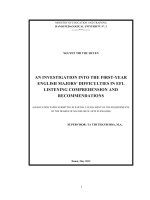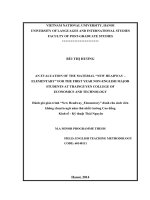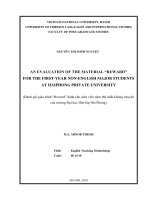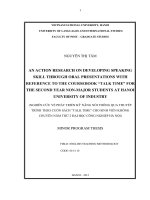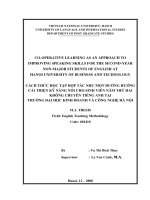An evaluation of the application of the courseware learn to speak english deluxe 10 in language lab for the first year non major of english students at hanoi university of business and technology
Bạn đang xem bản rút gọn của tài liệu. Xem và tải ngay bản đầy đủ của tài liệu tại đây (613.92 KB, 110 trang )
VIETNAM NATIONAL UNIVERSITY, HANOI
UNIVERSITY OF LANGUAGES & INTERNATIONAL
STUDIES FACULTY OF POST GRADUATE STUDIES
*****************
PHÙNG THỊ NHƯ TRANG
AN EVALUATION OF THE APPLICATION OF THE
COURSEWARE “LEARN TO SPEAK ENGLISH DELUXE 10” IN
LANGUAGE LAB FOR THE FIRST YEAR NON-MAJOR OF
ENGLISH STUDENTS AT HANOI UNIVERSITY OF BUSINESS
AND TECHNOLOGY
Đánh giá việc ứng dụng phần mềm chương trình dạy học “
Learn To Speak English Deluxe 10” tại phòng máy cho sinh
viên năm thứ nhất không chuyên Anh tại trường Đại Học
Kinh Doanh và Công Nghệ Hà Nội
M.A. MINOR PROGRAMME THESIS
Field: English Teaching Methodology
Code: 60140111
HANOI – 2015
VIETNAM NATIONAL UNIVERSITY, HANOI
UNIVERSITY OF LANGUAGES & INTERNATIONAL
STUDIES FACULTY OF POST GRADUATE STUDIES
*****************
PHÙNG THỊ NHƯ TRANG
AN EVALUATION OF THE APPLICATION OF THE
COURSEWARE “LEARN TO SPEAK ENGLISH DELUXE 10” IN
LANGUAGE LAB FOR THE FIRST YEAR NON-MAJOR OF
ENGLISH STUDENTS AT HANOI UNIVERSITY OF BUSINESS
AND TECHNOLOGY
Đánh giá việc ứng dụng phần mềm chương trình dạy học “
Learn To Speak English Deluxe 10” tại phòng máy cho sinh
viên năm thứ nhất không chuyên Anh tại trường Đại Học
Kinh Doanh và Công Nghệ Hà Nội
M.A. MINOR PROGRAMME THESIS
Field: English Teaching Methodology
Code: 60140111
Supervisor: Prof. Nguyêñ Hoa
HANOI – 2015
DECLARATION
I hereby certify that the thesis entitled
“ An evaluation of the application of the courseware Learn To Speak English
Deluxe 10 in language lab for the first year non major of English students at Hanoi
University of Business and Technology”
is the result of my own research for the Degree of Master of Arts, and that this
thesis has not been submitted for any degree at any other university or tertiary
institution.
Hanoi, 2015
Phùng Thị Như Trang
i
ACKNOWLEDGEMENTS
The author of this thesis is grateful to a great number of people who did offer
assistance and support in the preparation of the dissertation.
I am most grateful to Prof. Nguyễn Hòa- my supervisor. His guidance and
comments have helped me fulfill the thesis. Without his suggestions and guidance,
the thesis would never have been completed.
I would also like to thank the teachers at Hanoi University of Business and
Technology who did their best to help me gather data from students‟ and teachers‟
questionnaires.
This thesis would not have been completed without the enthusiasm and the
interest of the first year students in Accounting, Finance majors, who have
participated in the survey.
Finally, I own my deepest gratitude to my family for their great
encouragement and support.
ii
ABSTRACT
Applying technology and latest advance in learning is an investment and an
effort of both English Department of HUBT and the school. Learn To Speak
English is introduced to first year students of all majors but the results were not up
to expectation. Moreover, no courseware is perfect in any situations. For the
reasons, the study is aimed to evaluate the software to find out to what extent it can
meet teachers and students‟ needs in terms of contents and the presentation,
organization of the content as well as to find out some benefits and difficulties in
teaching and learning by using this software
To evaluate the software LTSE, this study was carried out based on the
criteria proposed by Georgiadou, E.,& Economides, A. (2000) as a basis. The data
were collected from first year students from different majors and ESP teachers at
HUBT.
In this study, the teachers and students‟ needs in language learning in terms
of content and the presentation, organization of the content of LTSE were
investigated. The evaluation also releases some strengths and weaknesses of this
software. And finally, the evaluator suggests some recommendations to make better
use of LTSE.
iii
LIST OF ABBREVIATIONS
HUBT:
Hanoi University of Business and Technology
LTSE:
“Learn to Speak English”
CALL:
Computer-Assisted Language Learning
iv
LIST OF TABLES, CHARTS
Chart 1: Results of difficulties in delivering LTSE lessons
Chart 2: Results of students’ evaluation of the most interesting and most difficult
lesson
Chart 3: Results of students’ recommendation to improve the use of LTSE
Table 1: Results of Students’ and teachers’ evaluation of LTSE’s content
Table 2: Results of Students’ and teachers evaluation of Pedagogical factors
Table 3: Results of Students’ and Teachers’ evaluation of Interactivity
Table 4: Results of students’ and teachers’ evaluation of Navigation of LTSE’s
content
Table 5: Results of students evaluation of Feedback of LTSE’s content
Table 6: Results of students’ and teachers’ evaluation of LTSE’s screen design
Table 7: Result of teachers’ opinion about the difficulties or the problems of
teaching with LTSE
Table 8: Results of teachers’ opinion about the benefits of teaching and learning
English at HUBT
Table 9: Results of Teachers’ recommendations to improve NDE
Table 10: Results of students’ perception and attitudes to NDE’ benefits
Table 11: Results of students’ evaluation of Challenges in LTSE studying
v
TABLE OF CONTENTS
DECLARATION...................................................................................................... i
ACKNOWLEDGEMENTS.................................................................................... ii
ABSTRACT...........................................................................................................iii
LIST OF ABBREVIATIONS................................................................................ iv
LIST OF TABLES, CHARTS................................................................................. v
PART I: INTRODUCTION.................................................................................... 1
1. Rationale of the study...................................................................................... 1
2. Aim of the study and research questions......................................................... 2
2.1 Aim of the study........................................................................................... 2
2.2 Research questions........................................................................................ 2
3. Scope of the study............................................................................................ 2
4. Significance of the study................................................................................. 3
5. Design of the study.......................................................................................... 3
PART II: DEVELOPMENT................................................................................... 5
CHAPTER ONE: THEORETICAL FRAMEWORK....................................... 5
1. Computer assisted language learning (CALL)............................................. 5
2. Criteria for evaluating language learning software....................................... 7
3. The software that has been used at HUBT................................................. 19
4. Learn to Speak English program................................................................ 22
CHAPTER TWO: METHODOLOGY AND DATA ANALYSIS...................24
1. Context of the study................................................................................... 24
2. Subjects...................................................................................................... 24
3. The instruments.......................................................................................... 25
4. Data collection and analysis....................................................................... 28
CHAPTER THREE: RESULTS AND DISCUSSION..................................... 29
1. Findings from part I of questionnaires and the interviews............................29
2. Findings from part II of the questionnaires and interviews...........................41
vi
3. Summary of major findings.......................................................................... 49
PART III: CONCLUSION................................................................................... 51
1. Conclusion..................................................................................................... 51
2. Limitations of the study................................................................................. 52
3. Recommendations for courseware improvements......................................... 53
4. Suggestions for further research.................................................................... 54
REFERENCES...................................................................................................... 55
APPENDICES...................................................................................................................................... I
vii
PART I: INTRODUCTION
1. Rationale of the study
For decades, English was taught in classrooms in which the teacher-centered
method was applied. The teacher gave information, while students gained
knowledge passively. However, advanced technology has influenced the educational
methods in classroom in which computer-based technology is mainly used to
reinforce instruction and put the focus on the students in their learning process.
Learners can use some English learning materials easily if they are equipped with a
device from very simple ones as their mobile phone, a radio, a cassette, etc. to a
more advanced one as laptops, ipads. And they can learn English anytime, anywhere
whenever they have time because learning English does bring pleasure and interests
besides leaving great impact on learner‟s listening skill improvement.
Among those conveniences, computer technology can be regarded as an educational
tool supporting language teaching. In fact, a wide range of electronic technologies
have been developed to supplement second language teaching and learning (Bas &
Kuzucu, 2009; Warschauer, 1996). These technologies include hardware delivery
methods such as audiotape recorders, videotape recorders, computers and the
Internet. In addition, there are many innovative electronic tools that support
language learning such as speech production and recognition, text analysis, text
translation, and software for visualization and animation, electronic mail, list serve
discussion groups, streaming audio and video and real-time synchronous as well as
asynchronous communication opportunities that bring the target language
environment to the learner (LeLoup & Porterio, 1997).
One of the recent educational methods for language teaching, more specifically
English Language teaching, is called the Computer Assisted Language Learning
(CALL) method which is combining with face to face classroom instruction to form
a new Blended Learning model. Learn To Speak English Deluxe 10 is one of those
1
advanced technology in language teaching and learning. At Ha Noi University of
Business and Technology (HUBT) after two years of experiment, the application of
Learn To Speak English Deluxe 10 Courseware has caused a controversy over its
effectiveness among teachers and students. Hence, this research is done to explore
to what extent this software meets teachers and students‟ needs in teaching and
learning as well as to reveal the benefits and challenges in applying LTSE so as to
find ways to improve the course.
2. Aim of the study and research questions
2.1 Aim of the study
The major aims of the study are:
- To evaluate the courseware Learn To Speak English Deluxe 10 used at
Hanoi University of Business and Technology in terms of content as well as
the presentation and organization of its content.
- To propose some recommendations for administrators and English teachers
to fully exploit and better apply the program supporting students in language
learning for expected results.
2.2 Research questions
In light of the goals of the study, the following research questions are made:
1. To what extent does LTSE meet teachers and students’ needs in
teaching and learning in terms of content as well as the presentation and
organization of its content?
2. What improvements can be recommended to make the use of the
LTSE courseware more effective?
3.
Scope of the study
This study tried to find out teachers and students‟ evaluation of the Learn To
Speak English Courseware in terms of these criteria: content and the presentation
and organization of its content. This kind of information was collected through
questionnaires and interview.
2
Due to the limited scope of a minor thesis, research subjects are primarily
confined to ten English teachers who have been working with the courseware for
two years and 100 random students who are learning at eight different classes of
Accounting, Banking, and Finance.
4. Significance of the study
Firstly, the study serves as a reference source for HUBT administrators and
English teaching staffs who are directly involved in Learn to Speak English
program and administrators as well as for students who are beneficiaries of the
program. They will be made aware of both the benefits and challenges in the
application of Learn to Speak English and thus promote the quality & effectiveness
of the program.
Secondly, based on the results of the study, some changes or improvements in the
use of the courseware in the teaching/learning process may be made accordingly in
order to serve best the goals of the English Department set for the teachers and
students in the first school year.
Thirdly, it would make a contribution to the research area in the field of computer
assisted learning as well as relating to the application of language learning
software.
Finally, the thesis would also be helpful for those who share similar concern with
the researcher.
5. Design of the study
This study consists of three parts:
Part I: Introduction. This part supplies an overview of the study with specific
reference to the rationale, the aims, and the design.
Part II: Development. In this part, three chapters are presented.
3
Chapter one: Theoretical Framework. This chapter deals with an exploration of the
theoretical background of the research. It concerns with the issues relevant to the
topic of the research: Computer Assisted Language Learning, Criteria for
evaluating language learning software, the software that has been used at HUBT,
Learn to Speak English program.
Chapter two: Methodology and data analysis. Methodology presents the
background information of the subjects of the study, the instrument used to collect
data, the procedure of data collection.
Chapter three: Results and Discussion. In this chapter, the data is analyzed in
detail and a thorough discussion of the findings of the study is made. Some
explanations and interpretations of the findings are also present in this chapter.
Part III: Conclusion. In this part, the limitations and some recommendations for
further research are explored.
4
PART II: DEVELOPMENT
CHAPTER ONE: THEORETICAL FRAMEWORK
1. Computer assisted language learning (CALL)
1.1. What is CALL?
According to Kocak (1997) CALL is “a term used by teachers and students to
describe the use of computers as part of a language course”. Hardisty & Windeatt
(1989) give a more detailed definition that CALL is traditionally considered as a
method of 'presenting, reinforcing and testing' particular language items in which
the learner is first presented with a rule and some examples, and then answers a
series of questions which test her/his knowledge of the rule and the computer gives
appropriate feedback and awards a mark which may be stored for later inspection
for the teacher and reference for the learner.
1.2. Impacts of CALL on language learning and teaching
In fact, CALL has a lot of effects on language learning in term of methods, context
and language knowledge acquisition. Higgins (1995) indicates that the value of
CALL is that it allows a richer form of language exploration and the use of
computers is compatible with a variety of approaches, methods and techniques. This
gives teachers much flexibility in their teaching practice. According to Kramsch and
Andersen (1999) multimedia technology can provide authentic cultural contexts that
are important for language learning. In other words it creates a supportive learning
environment. Kocak‟s (1997) study investigates the effectiveness of CALL on
vocabulary learning and teaching and draws a conclusion that “computer instruction
may offer a noteworthy experience to students with respect to vocabulary learning”.
Besides, CALL considerably influences the development of language skills. As
some researchers who advocated CALL programs, especially voice-interactive, say
that CALL can improve learners' speaking skills. Moreover, computer technology in
combination with a conferencing system is considered an effective means of
5
providing goal-directed writing courses tailored to different learning styles. So,
making complete use of CALL to develop integrative language skills is truly
valuable in language teaching and learning.
However, working with the computer, as any other teaching aid, needs to be linked
with ordinary classroom work and CALL lessons, like other lessons, need to be
planned carefully because Jones & Fortescue (1987) warns that the computer is a
resource and not a programmed-learning machine.
1.3. Lance Knowles( 2004)’ CALL
Long-Term Memory
Working Memory
Visual
The diagram shows how various processors in the brain communicate with the
working memory, which is instrumental in the learning process. The multiple
processors such as the visual, auditory, conceptual and many others are involved
and can be activated in well-designed activities. In addition, these processors work
in parallel in the unconscious process and interact with the working memory and
long term memory to interpreted language. In fact, when languages are repeated
many times, neurons are connected, and then create automaticity. Making use of this
working process of the brain, people create a new model of language learning
naming Computer Assisted Language Learning (CALL). CALL can simultaneously
activate auditory, phonological, and visual systems in the brain.
Lance Knowles (2004) states that CALL is an emerging force in language education
and affirms that “CALL is now moving toward a blended model where the
computer provides the necessary optimal input and practice activities, and the
6
classroom provides the human element accommodating and utilizing the needs and
lives of the learners in a social context”. Besides, he shows the different but
essential roles of “both multimedia and classroom activities”. Without the effective
practice provided by well-designed, media-rich courseware, language learning is
slow, painful and discouraging. However, without social environment of classroom,
learning is tedious, unmotivating, and too restrictive to meet the learners‟ needs.
Moreover, he argues that learners‟ practice should be assisted by teachers who point
out practice strategies and materials so that students practice English more
effectively.
2. Criteria for evaluating language learning software
2.1. Criteria suggested by Hubbard
Hubbard (1988) develops an integrated framework for CALL courseware
evaluation. Its approach is different from others and requires some introduction. It is
an integrated description of the components of CALL materials with respect to a
particular goal- evaluation. This framework helps an evaluator create his or her own
questions or develop some other evaluation scheme instead of asking specific
questions.
Rather than asking a specific set of questions, a framework provide the tool through
which an evaluator can create on his or her own questions or develop some other
evaluation scheme. He also gives four principles when using the framework.
-
Principle 1: the evaluation framework should be linked to a general
framework for language teaching methodology. In other words, it should build as
much as possible on existing views of how to analyze the effectiveness of the
language process.
-
Principle 2: the evaluation framework should contain a wide range of
methods, teachers, learners, and syllabus goals. It should be flexible and nonjudgmental of the nature of language and learning.
7
-
Principle 3: the evaluation framework should be connected with frameworks
for courseware development and implementation in terms of form and terminology.
That is, the evaluation process should not be secluded from the process of
developing and using courseware, but comprise just one module of a
comprehensive methodological framework for CALL.
-
Principle 4: the evaluation framework should express dependencies among
different components of CALL. Apparently these components interact in non-linear
ways. Therefore, the framework should be designed in order that the evaluation
process should not operate exclusively in a linear manner.
The researcher considers these principles to be of great significance in courseware
evaluation and should be applied widely and seriously. It should be noted that this
framework is built on a view of the language teaching/learning process proposed
by Richards and Rogers (1986). They think that when analyzing any method of
language teaching method, there are three levels to consider: approach, design, and
procedure. Basically, approach represents the method‟s assumptions about the
nature of language and language learning; design represents the realization of
those assumptions in terms of curricular goals, learning tasks, and the roles of
learner, teacher, and materials; and procedure represents the implementation of
those goals through specific learning and practice activities. This point of view
remains important in Hubbard (1988)‟s framework. However, some modifications
have been made. Because the Richards and Rogers framework is designed to
analyze whole methods rather than individual pieces of courseware, some
significant liberties have been taken to accommodate the rather different goals of
courseware evaluation. Following is Hubbard (1988)‟s integrated framework for
CALL courseware evaluation.
8
Hubbard’s integrated framework for CALL software evaluation
2.2. Criteria suggested by Burston
Based on the work of Hubbard (1987, 1988), Burston (2003) suggest a frame work
with four parameters which could be used as a basic guide to software evaluation:
technical features, activities (procedures), teacher fit (approach), and learner fit
(design).
Technological features seem to be the easiest to assess and include:
9
1.
simplicity of installation (adequacy of instructions, trouble free, easy to
uninstall),
2.
speed of program operation (where are the delays: at start up, loading videos,
web page loading?),
3. reliability of operation (crashes and stalls),
4.
platform compatibility (PC/Macintosh, operating system, Web browser
versions),
5. screen management (esthetics, navigational transparency),
6. user interface (ease of use, operational consistency, online help), and
7.
exploitation of computer potential (effective use of sound, video, speech
recognition, speech synthesis, intelligent response handling, student record keeping,
adaptability based on user profiles, links to www).
Just like technological features, program activities are relatively straightforward to
deal with. It is all about finding out what students actually do when using the
program and how good the activities are. The results should be made to be relative
to activity type. For instance, using grammar exercises may be opposed by some
teachers but in evaluating such exercises, it cannot be denied that they are useful.
The quality of exercises has to be judged relative to their instructional purpose. (The
appropriateness of activities, which is another issue depending on the teacher‟s
particular curricula objects, will be dealt later in Teacher Fit parameter). Broadly
speaking, activities can be classified into three major types:
1. instructional (tutorials, drills, text reconstruction),
2. collaborative (games, simulations, discussion forums, peer group writing),
and
3.
facilitative (dictionary, database, verb conjugator, spell/grammar checker,
authoring system).
Obvious activity features to consider are:
1. linguistic focus (discourse, syntax, lexis, morphology, spelling,
pronunciation),
2. language skills (reading, listening, writing, speaking),
10
3. sociolinguistic focus (information gathering/authentic tasks), and
4. supplementary/complementary/central relationship to the curriculum.
The assessment of teacher fit (approach) requires looking at the theoretical base of
student activities; judging how well they follow accepted theories of cognitive
development, second language acquisition, and classroom methodology; and
determining how closely they fit the teacher's curricular objectives. Doing this,
teachers can show their rejection to the activities of the software program for not
according with collaborative objectives.
Linguistic accuracy (e.g., grammaticality, authenticity, typos, etc.) and the
appropriateness of sociocultural representations (e.g., stereotypes or gender bias)
also reflect the how well pedagogical objectives of the program are met.
Teacher fit is the parameter that determines the pedagogical appropriateness of the
program; therefore considered to be the most critical one of software evaluation.
Even though a program is rich in activities or technically brilliant, it is useless if
does not help to fulfill teacher‟s curricular objectives. Determining teacher fit is the
most difficult partly because the theoretical/methodological assumptions inside the
program are not always stated by software developers, and assessors have to make
implication. On the other hand, software producers label their products basing on
favored methodological approaches (e.g., communicative, learner-centered,
constructivist, and experiential) rather than paying attention to the truth of the
matter. In addition, some foreign language teachers may not have adequate formal
training (e.g., in cognitive psychology, applied linguistics, or language teaching
methodology) required to make decisions about theoretical considerations.
The step of assessing learner fit (design) involves defining the potential user of the
software program in which teachers play an essential role. Other factors such as
which the program is appropriate to or can be adapted to, the needs for students are
also determined by them. Learner fit is affected by the following:
1.
linguistic level (grammar, vocabulary, register),
11
2.
response handling (error correction, feedback),
3.
adaptation to individual learner differences (age, interests),
4.
learning styles (recognition, recall, comprehension, experiential
learning),
5. learningstrategies(field-dependent/field-independentlearning,
deductive/inductive reasoning, visual-graphic/visual-textual learning,
individual/group work),
6.
learner control (sequencing, content, operating parameters), and
7.
design flexibility/modifiability by instructor.
Burston (2003) also suggests that the easiest way to select software is to select
bundled software: “an integrated software/textbook package” because “the content
is age and language-learning level appropriate, the methodology is sound, and total
curricular investigation is assured” (p.36). His framework is of great significance in
the assessment of the application of a language learning courseware.
2.3. Criteria suggested by Lê and Lê
As cited in Quynh Lê and Thao Lê (2007), software is looked at in different aspects.
It can be seen as a tool, an instructor, a facilitator of learning, and a virtual class. In
the context of NDE, a virtual class may be the best comparison because the students
self-study in the virtual environment with the help of the teacher. These authors take
into account the following factors of educational software evaluation:
-
Flexibility: A courseware should be flexible enough to serve up learners‟
learning styles and interests when they negotiate through their learning and to
allow the learners to learn at their own pace.
-
Interactivity: This includes textual and communicative interactivity. In
terms of textual interactivity, learners can explore a variety of structure-based and
content-based parts of the courseware. Communicatively, a communication board
is used for discussion among participants.
12
-
Multimedia power: A range of multimedia tools are embedded in the
courseware for learners to construct their own materials and to access other
sources.
-
Resources: Promoting independent learning is of importance. Reading
materials include scanned articles from books and those available on the Web.
The presence of guided tours of various web sites which deal with specific topics
is advisable.
-
A wide range of learning experiences: Apart from the content-based
topics dealing with different aspects of a course, there should be different subcomponents such as practical implications, problem-solving tasks, and selftesting.
-
Learners’ evaluation: It is a good ideas for the courseware to include a
component to provide a user-friendly facility for students to contribute their
evaluation and feedback.
The process of educational software evaluation is presented in the following
diagram.
Lê & Lê (2007)’s process of educational software evaluation
13


